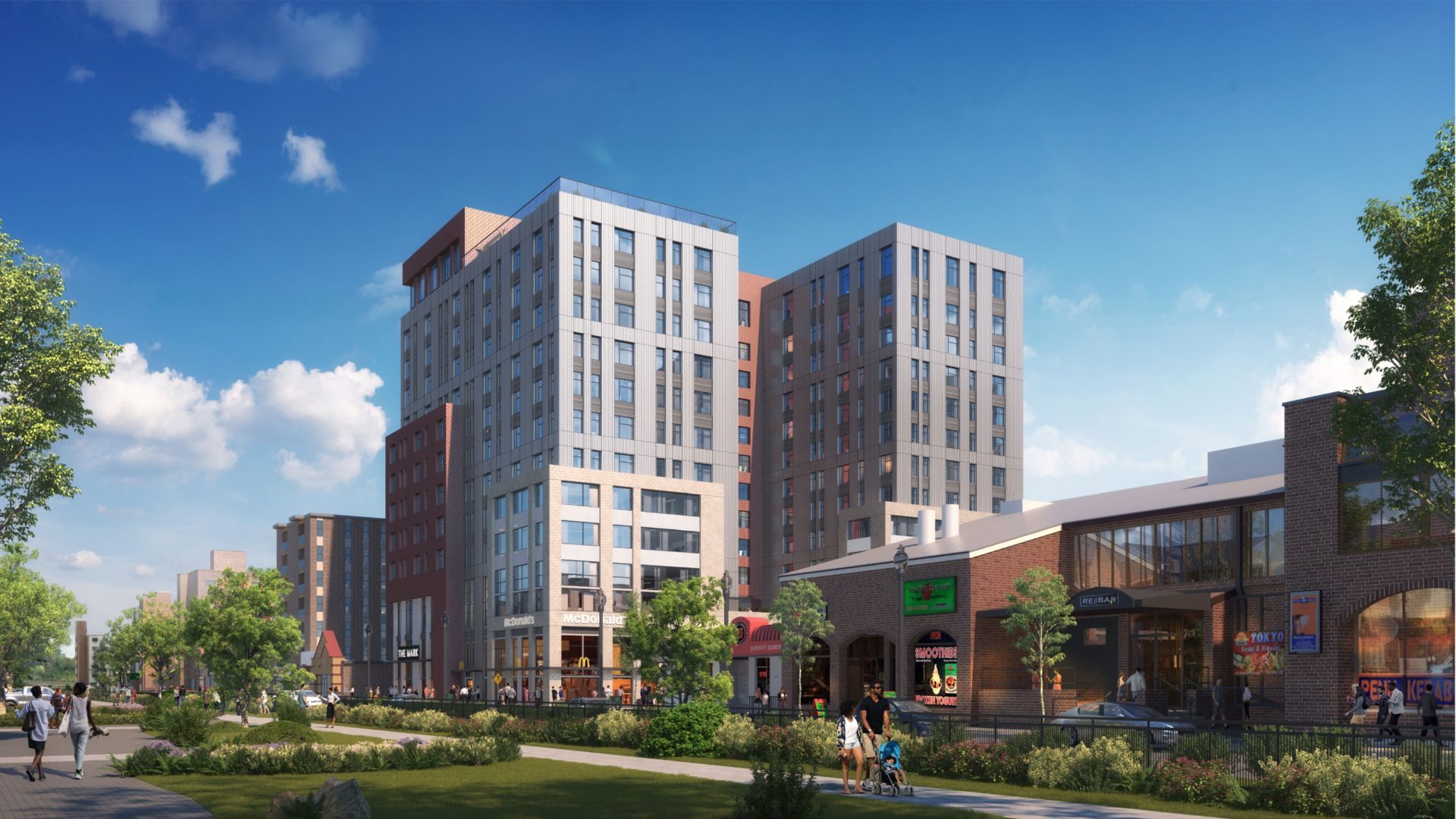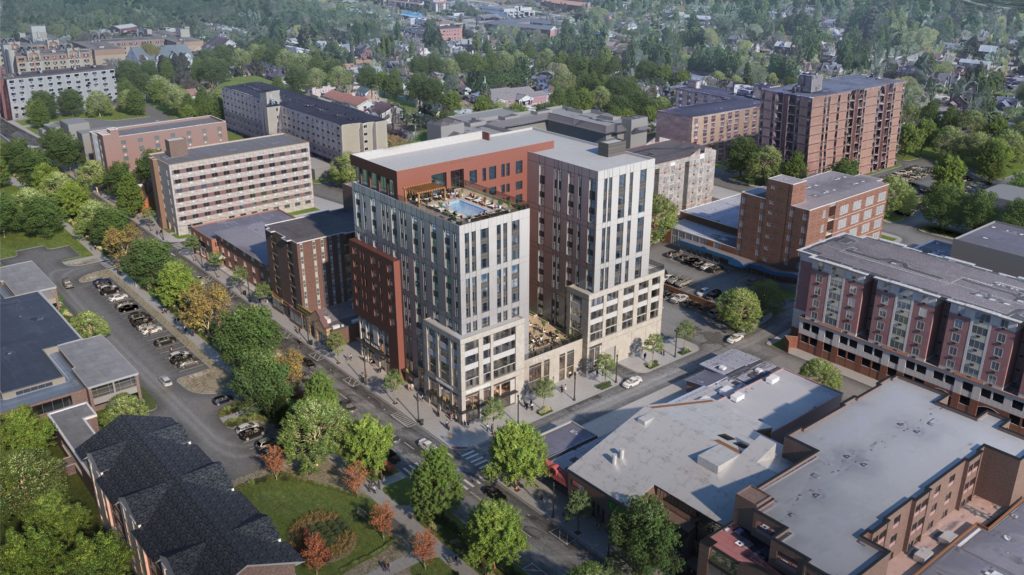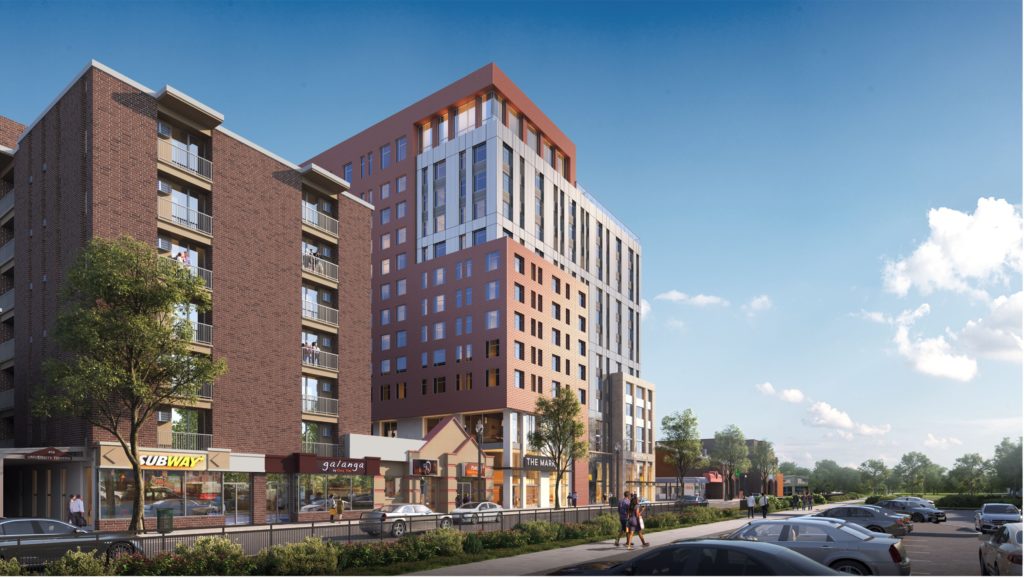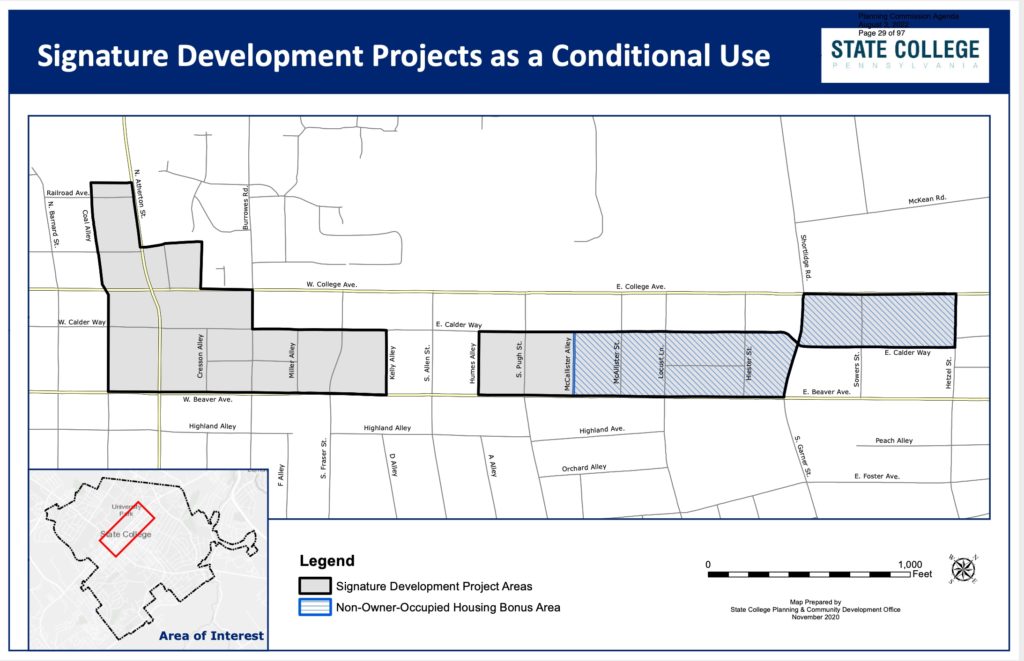
A design rendering depicts The Mark high-rise in downtown State College as viewed from East College Avenue looking east. Image by Cube 3

A design rendering depicts The Mark high-rise in downtown State College as viewed from East College Avenue looking east. Image by Cube 3
A student housing developer has submitted plans for another 12-story, mixed-use building in downtown State College.
With a pending zoning change that could be enacted as early as next month, borough officials believe that Landmark Properties’ plans for the 155-foot tall The Mark could be the final high-rise of its kind to be developed in the downtown for the foreseeable future.
The Mark would be located at the corner of East College Avenue and Sowers Street. It would involve the demolition of the Keystone Building at 444 E. College Ave., McDonald’s at 442 E. College Ave. and the Armenara Office Building at 111 Sowers Street.
Design renderings for The Mark show McDonald’s, which owns its current building downtown, would be located on the ground floor of the new building. It was not clear if any businesses from the other buildings, including Are U Hungry on Sowers Street, would also be included in The Mark.
A spokesperson for Landmark Properties declined comment.

Plans submitted to the borough on Aug. 11 show 19,955 square feet of commercial space on the first and second floors. The ground floor plan has two commercial spaces and a leasing office, while the second floor shows a 10,780-square-foot commercial office space, a 10,455-square-foot “resident amenity” area and a 3,600 square-foot courtyard.
The third through 12th floors would have 167 apartment units ranging from studios to five-bedrooms, for a total of 473 beds.
Parking for 289 vehicles would mostly be located in a three-level underground parking facility, which also includes bicycle storage. Renderings show a pool on the rooftop.

Landmark Properties owns five other student apartment complexes in the State College area: The Station, The Retreat, The Legacy, The Standard and The Metropolitan.
The latter two are among six 12-story buildings that have either opened or are under construction in State College since 2016. That list also includes the Fraser Centre, The Rise, The Maxxen and oLiv State College, which is under construction by developer Core Spaces at the corner of East College Avenue and Hetzel Street.
Just a block away from oLiv, The Mark would be the seventh, and possibly the final 12-story building to be constructed downtown.
Planning commission is expected to review the land development plan for The Mark in September. The plan also will require conditional use permit approval from borough council.
Zoning Amendment Expected to Deter Future High-Rise Development
At its Sept. 12 meeting, State College Borough Council will hold a public hearing and potentially enact a zoning text amendment for the Signature Development Overlay of the Commercial Incentive District that would likely deter future high-rise development. (The zoning change would not apply to The Mark because Landmark Properties has already submitted a formal land development plan.)
Council previously narrowed the area where large, primarily student housing complexes can effectively be built downtown with a zoning amendment in 2017. But the pending zoning change would eliminate the “bonus” that allows for higher density residential use when the use is non-owner-occupied from the eastern end of downtown where it currently is still permitted.
“Recently, when we started having joint meetings with planning commission, council and the zoning revision committee, it became pretty clear that there was interest in removing that bonus from the rest of downtown,” Ed LeClear, borough planning director, said.
The bonus is based on floor area ratios for commercial and residential space in a building. In 2005, when council adopted the Signature Development Overlay that eventually enabled construction of the Fraser Centre, it was aimed at creating predominantly commercial projects, with a minimum of 40% non-residential space and a maximum residential floor area ratio of 3.0.
“Basically, not as residentially dense, not as many residential units and more commercial space,” LeClear said. “You see that today with the Fraser Centre. It’s mostly commercial with the owner-occupied condos on top.”
But in 2013, council made the commercial floor area ratio 1.0 and increased the residential to 5.0. in the Signature Development Overlay.
“That is the change that really made the zoning more permissible for what ended up becoming purpose-built student housing,” LeClear said. “That coincided with a national wave of purpose-built student housing. You had an industry and a lot of equity that was interested in investing in that industry… So the combination of that zoning change in ‘13 and the national market change is really what led to the number of new high-rises coming into downtown.”
In 2017, council removed the bonus from the western part of the overlay, but left it in place east of McAllister Alley because the eastern end of downtown has historically had the highest concentration of student housing in the borough. Since then, the bonus has been used by developers for The Maxxen, which opened in 2020 on the site of the former Garner Street parking lot, oLiv State College, which is expected to be completed next year, and the plan for The Mark.

Now it appears council may remove the bonus altogether.
Reverting to the 40% non-residential requirement that’s in place elsewhere in the district makes it unlikely student housing developers will be interested in constructing more high-rises downtown, LeClear said. He added that the Fraser Centre was developed on what was borough-owned property and with significant redevelopment funding from the state.
“That change in ’13 was really what made a more permissive environment,” LeClear said. “With that being removed, you could still build another Fraser Centre, but I just don’t see the market there for that… It’s highly unlikely that we would see another one built under current zoning.”
Receive all the latest news and events right to your inbox.

80% of consumers turn to directories with reviews to find a local business.